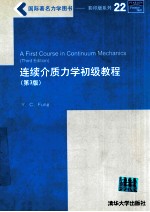图书介绍
连续介质力学初级教程 第3版pdf电子书版本下载

- 冯元桢著 著
- 出版社: 北京:清华大学出版社
- ISBN:7302121389
- 出版时间:2005
- 标注页数:311页
- 文件大小:45MB
- 文件页数:331页
- 主题词:连续介质力学-高等学校-教材-英文
PDF下载
下载说明
连续介质力学初级教程 第3版PDF格式电子书版下载
下载的文件为RAR压缩包。需要使用解压软件进行解压得到PDF格式图书。建议使用BT下载工具Free Download Manager进行下载,简称FDM(免费,没有广告,支持多平台)。本站资源全部打包为BT种子。所以需要使用专业的BT下载软件进行下载。如 BitComet qBittorrent uTorrent等BT下载工具。迅雷目前由于本站不是热门资源。不推荐使用!后期资源热门了。安装了迅雷也可以迅雷进行下载!
(文件页数 要大于 标注页数,上中下等多册电子书除外)
注意:本站所有压缩包均有解压码: 点击下载压缩包解压工具
图书目录
1 Introduction 1
1.1 The objective of this course 1
1.2 Applications to science and technology 2
1.3 What is mechanics? 2
1.4 A prototype of a continuum:The classical definition 2
1.5 Our definition of a continuum 3
1.6 The concept of stress in our definition of a continuum 4
1.7 Abstract copy of a real continuum 5
1.8 What is continuum mechanics about? 6
1.9 Axioms of continuum mechanics 7
1.10 A biological example of a hierarchy of continua depending on the size of the object involved in a scientific inquiry 7
1.11 Elementary topic through which basic ideas evolved 12
2 Vectors and Tensors 39
2.1 Vectors 39
2.2 Vector equations 41
2.3 The summation convention 44
2.4 Translation and rotation of coordinates 49
2.5 Coordinate transformation in general 53
2.6 Analytical definitions of scalars,vectors,and Cartesian tensors 55
2.7 The significance of tensor equations 58
2.8 Notations for vectors and tensors:Boldface or indices? 58
2.9 Quotient rule 59
2.10 Partial derivatives 60
3 Stress 64
3.1 The idea of stress 64
3.2 The laws of motion 66
3.3 Cauchy's formula 69
3.4 Equations of equilibrium 72
3.5 Change of stress components in transformation of coordinates 75
3.6 Stress components in orthogonal curvilinear coordinates 76
3.7 Stress boundary conditions 78
4 Principal Stresses and Principal Axes 88
4.1 Introduction 88
4.2 Plane state of stress 89
4.3 Mohr's circle for plane stress 92
4.4 Mohr's circles for three-dimensional stress states 94
4.5 Principal stresses 94
4.6 Shearing stresses 97
4.7 Stress-deviation tensor 99
4.8 Lamé's stress ellipsoid 102
5 Analysis of Deformation 112
5.1 Deformation 112
5.2 The strain 115
5.3 Strain components in terms of displacements 117
5.4 Geometric interpretation of infinitesimal strain components 119
5.5 Infinitesimal rotation 121
5.6 Finite strain components 122
5.7 Principal strains:Mohr's circle 124
5.8 Infinitesimal strain components in polar coordinates 125
5.9 Direct derivation of the strain-displacement relations in polar coordinates 128
5.10 Other strain measures 131
6 Velocity Fields and Compatibility Conditions 145
6.1 Velocity fields 145
6.2 The compatibility condition 146
6.3 Compatibility of strain components in three dimensions 148
7 Constitutive Equations 154
7.1 Specification of the properties of materials 154
7.2 The nonviscous fluid 155
7.3 Newtonian fluid 156
7.4 Hookean elastic solid 157
7.5 Effect of temperature 161
7.6 Materials with more complex mechanical behavior 161
8 Isotropy 165
8.1 The concept of material isotropy 165
8.2 Isotropic tensor 165
8.3 Isotropic tensors of rank 3 169
8.4 Isotropic tensors of rank 4 170
8.5 Isotropic materials 172
8.6 Coincidence of principal axes of stress and of strain 172
8.7 Other methods of characterizing isotropy 173
8.8 Can we recognize a material's isotropy from the microstructure? 173
9 Mechanical Properties of Real Fluids and Solids 181
9.1 Fluids 181
9.2 Viscosity 183
9.3 Plasticity of metals 186
9.4 Materials with nonlinear elasticity 188
9.5 Nonlinear stress-strain relationships of rubber and biological tissues 191
9.6 Linear viscoelastic bodies 193
9.7 Quasi-1inear viscoelasticity of biological tissues 197
9.8 Non-Newtonian fluids 201
9.9 Viscoplastic materials 202
9.10 Sol-gel transformation and thixotropy 204
10 Derivation of Field Equations 209
10.1 Gauss's theorem 209
10.2 Material description of the motion of a continuum 212
10.3 Spatial description of the motion of a continuum 214
10.4 The material derivative of a volume integral 215
10.5 The equation of continuity 217
10.6 The equations of motion 218
10.7 Moment of momentum 219
10.8 The balance of energy 220
10.9 The equations of motion and continuity in polar coordinates 223
11 Field Equations and Boundary Conditions in Fluid Mechanics 231
11.1 The Navier-Stokes equations 231
11.2 Boundary conditions at a solid-fluid interface 233
11.3 Surface tension and the boundary conditions at an interface between two fluids 235
11.4 Dynamic similarity and Reynolds number 238
11.5 Laminar flow in a horizontal channel or tube 240
11.6 Boundary layer 244
11.7 Laminar boundary layer over a flat plate 247
11.8 Nonviscous fluid 249
11.9 Vorticity and circulation 251
11.10 Irrotational flow 253
11.11 Compressible nonviscous fluids 254
11.12 Subsonic and supersonic flow 257
11.13 Applications to biology 265
12 Some Simple Problems in Elasticity 270
12.1 Basic equations of elasticity for homogeneous.isotropic bodies 270
12.2 Plane elastic waves 272
12.3 Simplifications 274
12.4 Torsion of a circular cylindrical shaft 274
12.5 Beams 278
12.6 Biomechanics 281
13 Stress,Strain,and Active Remodeling of Structures 285
13.1 Introduction 285
13.2 How to discover the zero-stress state of materialin a solid body 285
13.3 Remodeling the zero-stress state of a structure:A biological example of active remodeling due to change in stress 288
13.4 Change of zero-stress state with temperature:Materials that“remember"their shapes 290
13.5 Morphological and structural remodeling of blood vessel due to a change in blood pressure 292
13.6 Remodeling of mechanical properties 294
13.7 Stress analysis with the zero-stress state taken into account 296
13.8 Stress-growth relationship 299
Index 302